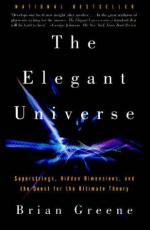
|
| Name: _________________________ | Period: ___________________ |
This quiz consists of 5 multiple choice and 5 short answer questions through Chapter Nine: The Smoking Gun, Experimental Signatures.
Multiple Choice Questions
1. Which of the following is true regarding our current knowledge of the Calabi-Yau space?
(a) Its shape is completely known and defined.
(b) Its shape is totally unknown.
(c) Physicists and mathematicians disagree about its shape.
(d) Its shape is not fully known.
2. What is the photoelectric effect?
(a) Electrons and photons only interact if they have the same frequency.
(b) Photons can spontaneously decay into electrons in powerful magnetic fields.
(c) When light shines on metals, the metals emit electrons.
(d) Electrons follow quantum paths made by photons.
3. What spin do all particles of matter have?
(a) 1/2.
(b) 2.
(c) 3/2.
(d) 1.
4. Which of the following is a correct statement, based on the theory of special relativity?
(a) Time is always the same to all observers, but space is not.
(b) Energy only exists relative to mass.
(c) Time and space are not experienced exactly the same by all observers
(d) Movement can only be measured relative to very massive objects, such as stars.
5. What is one of the difficulties in determining the shape of the Calabi-Yau space?
(a) There are an infinite number of unknowns in its governing equation.
(b) The equations governing its shape are too complex.
(c) No field of mathematics exists to support it.
(d) The shape has an unequal number of real and imaginary dimensions.
Short Answer Questions
1. What is the quantum, or messenger particle, of the strong force?
2. There are many possible Calabi-Yau spaces, but only shapes with which of the following characteristics are considered real possibilities?
3. Which of the follow best describes a boson?
4. Which of the following is true regarding the mass and spin of a pair of superpartners?
5. What property of electromagnetic waves did Max Planck solve the thermodynamic problem of the oven by discovering?
|
This section contains 405 words (approx. 2 pages at 300 words per page) |

|




